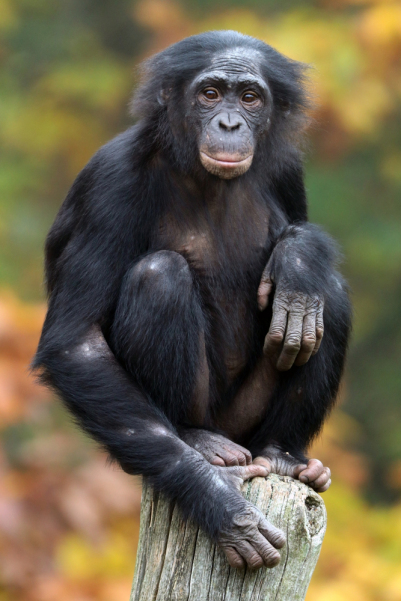
The Bonobo(Pan paniscus) also known as Pygmy Chimpanzee, Dwarf Chimpanzee, or Gracile Chimpanzee is a great ape classified in the Mammalian order Primates and family Hominidae.
Physical Characteristics
A Bonobo has black fur on its body, however the fur may turn gray as an individual ages. Bonobos’ faces are black and they have pink lips. The average body weight of a Bonobo is 41 kilograms(90 pounds), and when standing upright Bonobos average 1.1(3’7”) meters tall. The length of a Bonobo from the nose to rump while on all fours is 70 to 83 cm (2 ‘4” to 2 ‘9″). Males are typically larger than females. The Bonobo is more comfortable walking upright than the Chimpanzee(Pan troglodytes). Bonobos can be both arboreal and terrestrial.
| Genus | Pan |
| Species | P. paniscus |
| Binomial Name | Pan paniscus |
| Length (nose to rump) | 70 to 83 cm (2 ‘4” to 2 ‘9″) |
| Upright Height | 90 cm to 1.3 m(2’11” to 4’3”) |
| Weight | 26 to 61 kg(57 to 137 lbs.) |
| IUCN Status | Endangered |
Range And Habitat
The Bonobo lives in The Democratic Republic Of The Congo where they inhabit forests which are found south of the Congo River and North of the Kasai River.
Breeding
After a gestation period of about 8 months a mother Bonobo gives birth to usually 1 baby, however twins may be born but that is rare.
Diet
The Bonobo eats primarily fruit but also eats leaves, seeds, small vertebrates, worms, insects, and fish.
Predators
Uncertain
Fun Facts
- The first baby Bonobo born at a zoo in the United States was born at the San Diego Zoo.
- Bonobos can live for up to 50 years.
- Bonobos are less fearful of water than the Chimpanzee(Pan troglodytes).
- February 14th(Valentine’s Day) has been declared World Bonobo Day by the African Wildlife Federation.
